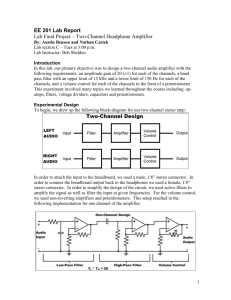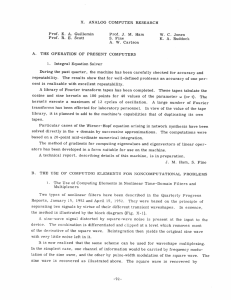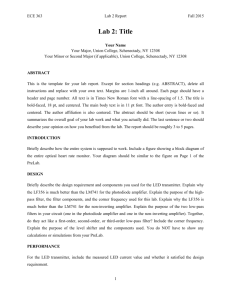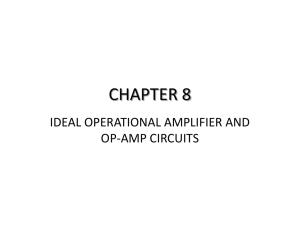Lab Guide
advertisement
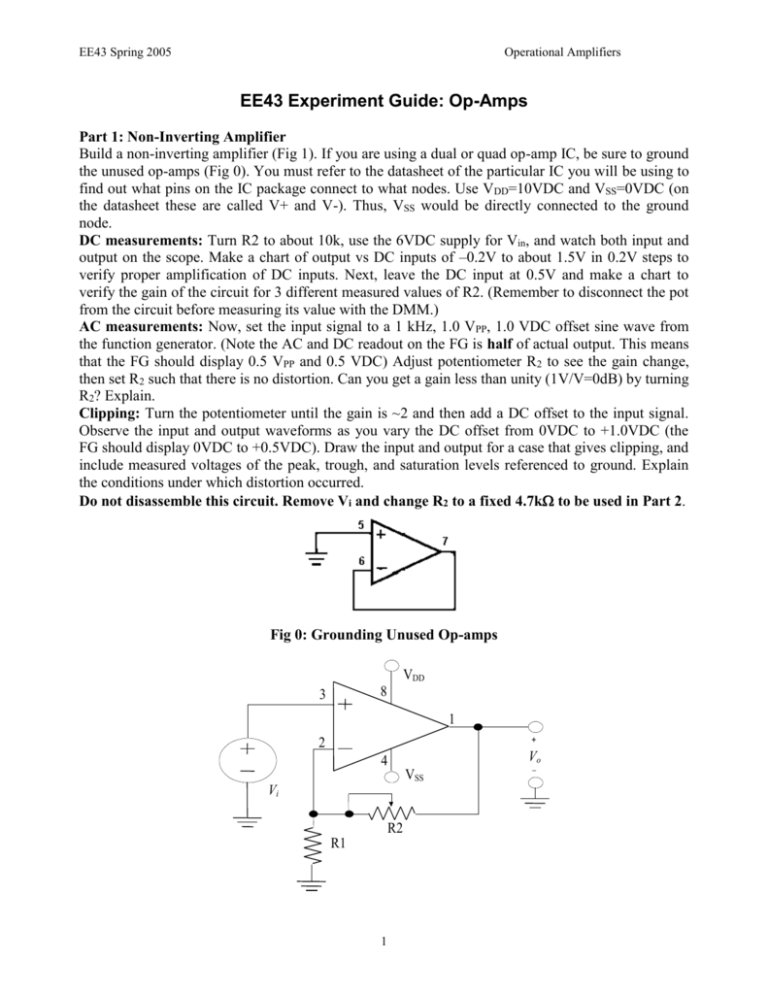
EE43 Spring 2005 Operational Amplifiers EE43 Experiment Guide: Op-Amps Part 1: Non-Inverting Amplifier Build a non-inverting amplifier (Fig 1). If you are using a dual or quad op-amp IC, be sure to ground the unused op-amps (Fig 0). You must refer to the datasheet of the particular IC you will be using to find out what pins on the IC package connect to what nodes. Use VDD=10VDC and VSS=0VDC (on the datasheet these are called V+ and V-). Thus, VSS would be directly connected to the ground node. DC measurements: Turn R2 to about 10k, use the 6VDC supply for Vin, and watch both input and output on the scope. Make a chart of output vs DC inputs of –0.2V to about 1.5V in 0.2V steps to verify proper amplification of DC inputs. Next, leave the DC input at 0.5V and make a chart to verify the gain of the circuit for 3 different measured values of R2. (Remember to disconnect the pot from the circuit before measuring its value with the DMM.) AC measurements: Now, set the input signal to a 1 kHz, 1.0 VPP, 1.0 VDC offset sine wave from the function generator. (Note the AC and DC readout on the FG is half of actual output. This means that the FG should display 0.5 VPP and 0.5 VDC) Adjust potentiometer R2 to see the gain change, then set R2 such that there is no distortion. Can you get a gain less than unity (1V/V=0dB) by turning R2? Explain. Clipping: Turn the potentiometer until the gain is ~2 and then add a DC offset to the input signal. Observe the input and output waveforms as you vary the DC offset from 0VDC to +1.0VDC (the FG should display 0VDC to +0.5VDC). Draw the input and output for a case that gives clipping, and include measured voltages of the peak, trough, and saturation levels referenced to ground. Explain the conditions under which distortion occurred. Do not disassemble this circuit. Remove Vi and change R2 to a fixed 4.7k to be used in Part 2. Fig 0: Grounding Unused Op-amps VDD 8 3 1 + 2 Vo 4 VSS Vi R2 R1 1 _ EE43 Spring 2005 Operational Amplifiers Fig 1:Non-inverting Amplifier 2 EE43 Spring 2005 Operational Amplifiers Part 2: Inverting Amplifier Using the unused op-amp of the IC, build the inverting amplifier as shown below (please use the unused op-amp now). While you are building a circuit, it is safer for the circuits if you turn the DC power supply OUTPUT OFF. Let the input signal be a 1 kHz, 1.0VPP sine wave, 0 VDC offset, turn R2 to max. What’s happening to the output signal? Adjust the input offset to make the output more complete. Now adjust the potentiometer and observe the resulting change in the amplitude and offset of the output. Adjust these two parameters until the gain is at its maximum and there’s no clipping. What range of gain do you have in this circuit? Verify the correct amplification of both AC and DC signals. What is the phase difference between Vout and Vin and where is it from? Is it a delay? R2 VDD R1 8 6 7 Vi 5 + Vo 4 _ VSS Part 3: Cascaded connection Now we will study a cascade connection of two amplifiers. Connect the output of the inverting amp to act as the input voltage for the non-inverting amp. Instead of using 10 k for the feedback resistor R2 in the circuits, use R2 = 4.7 k (or two 10k in parallel) in both circuits. The input signal should be a 1 kHz, 100 mVPP (50 mVPP on the function generator display) sine wave; you have to pick the correct offset for the circuit to amplify linearly. Adjust the input signal to make sure there is no clipping anywhere in the circuit. Measure the gain of each stage separately and then the overall gain of this cascaded circuit. Integrator: Put a 0.1 F capacitor in parallel with R2 in a new inverting amplifier and measure the time constant as you did in the RC lab. I used a 60 Hz 600mVPP -200mVDC square-wave input. After getting the waveforms and triggering correct, use the cursors to measure the time constant. Be careful that the cursor source is the correct waveform A1 or A2. You can turn off scope channel A2 if you only want to make measurements on A1. Compare the measured time constant with theory. See if you can find a square wave input that will produce a triangle wave output. (Hint: You need to increase the frequency to a value beyond the reciprocal of the time constant for the integrator to work.) Now change the function generator back to a sine wave input. Create a log plot of gain vs. frequency from 1Hz to 100kHz. Differentiator: Build the inverting amplifier but put a 0.1 uF capacitor in series with R1. Now it should not matter what offset you input, because the capacitor will block DC. Hook up V+ to a 5V VDC. Input a 500 Hz 600mVpp square wave and autoscale. Zoom into the waveform to measure the time constant. Compare the measured time constant with theory. What happens when the input is a triangle wave? 3


